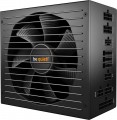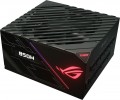Efficiency
Efficiency, in this case — the ratio of the power of the power supply (see "Power") to its power consumption. The higher the efficiency, the more efficient the power supply, the less energy it consumes from the network at the same output power, and the cheaper it is to operate. Efficiency may differ depending on the load; the characteristics can indicate both the minimum efficiency and its value at an average load (50%).
It should be noted that compliance with one or another level of 80PLUS efficiency directly depends on this indicator (for more details, see "Certificate").
Cooling system
—
1 fan. The most common option. The power of such a system is quite enough to cool the power supplies, including Above average and relatively inexpensive. On the other hand, fan operation creates noticeable noise, especially in low-cost power supplies with small diameter fans (see "Fan Diameter").
—
2 fans. The second fan is usually installed in powerful power supplies, for which the power of one fan is not enough. The price for such efficiency, in addition to increased cost, is an increased noise level.
— to
Semi-passive cooling. A function that allows you automatically turn off the PSU cooling system in situations where the load on the power supply is low and heat dissipation is reduced. It is found only in models with active cooling. Recall that systems of this type are more efficient than passive ones, but they consume additional energy and create noise during operation. Accordingly, at a light load, when intensive cooling is not required, it is more reasonable to turn off the fans — this saves energy and reduces the noise level.
—
Passive(radiators). Compared to fans, heatsinks have a number of advantages: for example, they do not create noise at all and do not require their own power supply (thus reducing overall power consumption). On the other hand, they are much less efficient, as a result — the power
...of power supplies with passive cooling does not exceed 600 watts. In addition, these PSUs are quite expensive.Fan bearing
The bearing is the piece between the rotating axle of the fan and the fixed base that supports the axle and reduces friction. The following types of bearings are found in modern fans:
— Sliding. The action of these bearings is based on direct contact between two solid surfaces, carefully polished to reduce friction. Such devices are simple, reliable and durable, but their efficiency is quite low — rolling, and even more so the hydrodynamic and magnetic principle of operation, provide much less friction.
— Rolling. They are also called "ball bearings", since the "mediators" between the axis of rotation and the fixed base are balls (less often — cylindrical rollers) fixed in a special ring. When the axis rotates, such balls roll between it and the base, due to which the friction force is very low — noticeably lower than in plain bearings. On the other hand, the design turns out to be more expensive and complex, and in terms of reliability it is somewhat inferior to both the same plain bearings and more advanced hydrodynamic devices. Therefore, although rolling bearings are quite widespread nowadays, however, in general, they are much less common than the mentioned varieties.
— Hydrodynamic. Bearings of this type are filled with a special liquid; when rotated, it creates a layer on which the moving part of the bearing slides. In this way, direct contact between hard surfaces is avoided and friction is significantly reduced compared to previous...types. Also, these bearings are quiet and very reliable. Of their shortcomings, a relatively high cost can be noted, but in fact this moment often turns out to be invisible against the background of the price of the entire system. Therefore, this option is extremely popular nowadays, it can be found in cooling systems of all levels — from low-cost to advanced.
— Magnetic centering. Bearings based on the principle of magnetic levitation: the rotating axis is "suspended" in a magnetic field. Thus, it is possible (as in hydrodynamic ones) to avoid contact between solid surfaces and further reduce friction. Considered the most advanced type of bearings, they are reliable and quiet, but expensive.
ATX12V version
A standard for power supplies that supplements the ATX specifications regarding power supply along the 12 V line. Introduced into use since the time of the Intel Pentium 4 processor. In the first series of the standard, the +5 V line was mainly used; from version 2.0, the +12 V line was introduced to fully power the components computer. Also in the second generation, a 24-pin power connector appeared, used in most modern motherboards.
EPS12V version
The version of the EPS12V standard that the power supply complies with. The EPS12V standard was created primarily for high consumption PCs (with a power of more than 700 W, see "Power") and entry-level servers. Such power supplies have a 24-pin plug for the motherboard and an 8-pin processor power connector (sometimes more than one, see “MB / CPU Power” for more details). They are also more reliable than ATX12V. They are compatible with most ATX standard motherboards, however, in older motherboards, there may be problems with matching connectors, so this issue should be clarified separately (however, to solve this problem, in some power supplies, parts of the plugs are made removable, which allows them to be reduced if necessary to the dimensions of the connectors on the motherboard).
SATA
The number of SATA power connectors provided in the PSU.
Nowadays, SATA is the standard interface for connecting internal hard drives, and it is also found in other types of drives (SSD, SSHD, etc.). Such an interface consists of a data connector connected to the motherboard, and a power connector connected to the PSU. Accordingly, in this paragraph we are talking about the number of SATA power plugs provided in the PSU. This number corresponds to the number of SATA drives that can be simultaneously powered from this model.
MOLEX
The number of Molex (IDE) connectors provided in the design of the power supply.
Initially, such a connector was intended to power peripherals for the IDE interface, primarily hard drives. And although the IDE itself is completely obsolete today and is not used in new components, however, the Molex power connector continues to be installed in power supplies, and almost without fail. Almost any modern PSU has at least
1 – 2 of these connectors, and in high-end models this number can be
7 or more. This situation is due to the fact that Molex IDE is a fairly universal standard, and with the help of the simplest adapters, components with a different power interface can be powered from it. For example, there are Molex - SATA adapters for drives, Molex - 6 pin for video cards, etc.
PCI-E 16pin
the 16-pin PCI-E power connector is designed to replace the existing 8-pin counterparts. It consists of twelve lines for current supply and four more for data transmission. The connector provides up to 600 W of additional power, which is a fourfold increase in power compared to 8-pin versions of the interface. Additional PCI-E connectors of all formats are used to power those types of internal peripherals that are no longer enough with 75 W supplied directly through the PCI-E socket on the motherboard.
Braided wires
The presence of a braid in the complete wires of the system unit — for all or at least for some.
This feature has a positive effect on reliability, making the wire as resistant as possible to bending, abrasion, strong pressure and other similar influences; it also provides additional protection against accidental contact with sharp objects (for example, when repairing a PC). The disadvantages of braided wires, in addition to increased cost, are also increased thickness and greater rigidity than similar cables in conventional insulation. This can create some difficulties in organizing space inside the system unit.

